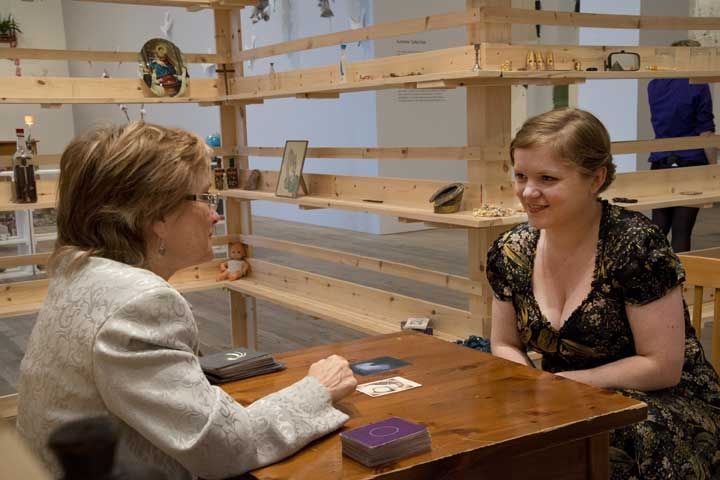Each of the 12 themed spaces in Beninese artist Meschac Gaba’s Museum of Contemporary African Art (1997–2002) integrates artworks with objects from everyday life that, from a Western perspective, might once have been viewed as belonging to either European/North American or African culture. So there is the Game Room, which features table-size sliding puzzles, the elements of which can be reconfigured to recreate the flag designs of various African countries, next to an oversize chessboard with one set of pieces covered in enlarged photocopies of euro banknotes and the other in copies of American dollars. Then there’s the Art and Religion Room, in which a cross-shaped, basic wooden shelving system contains, among other items, a menorah, a statue of Buddha and plastic Virgin Mary ‘holy water’ bottles, alongside items that may be fetishes or trinkets, such as peacock feathers, shells, a car’s wing-mirror and a horse’s hoof. And in each room references are made to two different forms of marketplace – the Beninese street market, evoked through the methods of display, for example, or the financial markets, highlighted by Gaba’s recurring motif of banknotes, employed in a variety of ways, including as cut-out circles that Gaba applies to the surfaces of other objects.
The equal cultural value of Western and non-Western art practices should be a given, but how these different practices are presented can still be problematic. It’s questions around this that Gaba’s work asks. What is the function of a museum? How is contemporary art from Western and non-Western cultures shown within it?
Gaba began this project in 1997 during a residency at Amsterdam’s Rijksakademie, adding to it room by room until it reached its current form in 2002. He may have initiated it from a concern that there wasn’t a space within the existing museum structure for the work he wanted to make, but there are more complex aspects to Gaba’s conflation of his actual life with the artworks that he makes.
This is best demonstrated in the Marriage Room, which contains gifts from and video documentation of Gaba’s wedding, in 2000, to Dutch design curator Alexandra van Dongen. The wedding took place in Amsterdam’s Stedelijk Museum – Gaba’s response to an invitation to participate in a show there. That a museum is both the location of the event and the context in which elements from it are subsequently shown, along with the way that the gifts are laid out to evoke a market-style display, again cleverly brings to the fore questions about how art is defined and valued.
In a year that will see the first African art fair held in London, coinciding with Frieze, Gaba’s exhibition seems all the more relevant. If the overarching point of his Museum is that contemporary African art is no more definable or homogeneous than contemporary ‘European art’ or contemporary ‘American art’, then he makes it very well.
This review was first published in the October 2013 issue.
